Overview
From natural sciences to social sciences, we will provide the course classes necessary to acquire the specialized knowledge and ability to respond to social demands that contribute to the sustainable production and use of forest resources, human survival, and environmental restoration. We will systematically organize from the perspective of basic and applied cross-disciplinary studies, and provide comprehensive education on global forest science under the sharing and cooperation of each educational field.
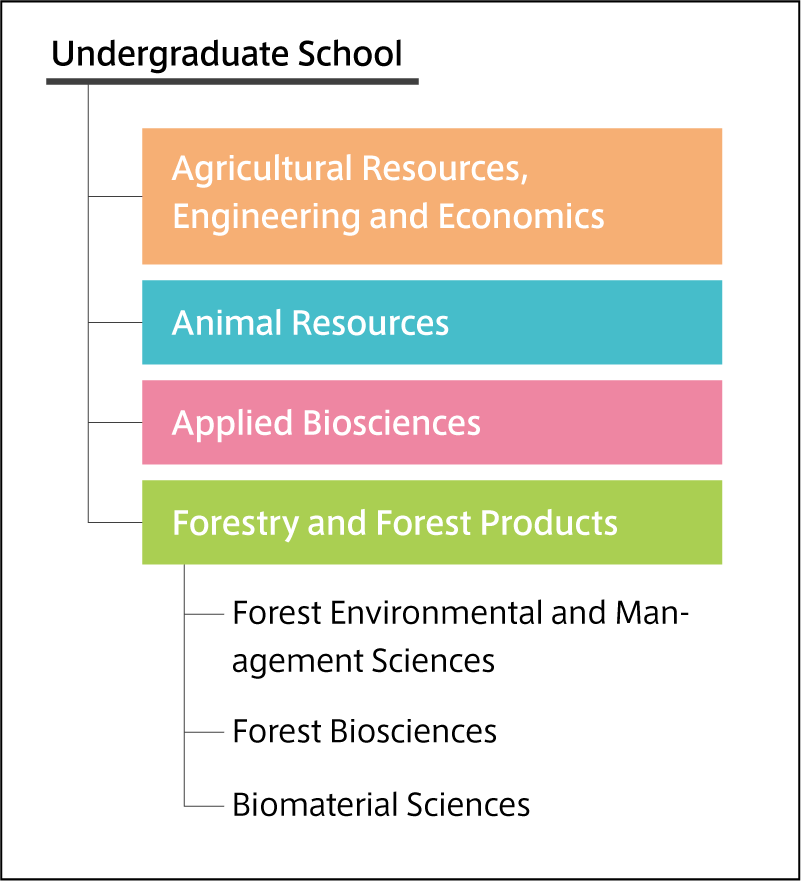
Forest Environmental and Management Sciences
Forests must be cultivated and managed over long periods of time, spanning multiple generations of people.
Seeking to achieve the preservation of the global environment and the sustainable production of forest resources, this study area covers a wide range of research topics, including preservation of the natural environment and land; elucidation of forest functions to prevent natural disasters; the development of new technologies related to measurements of forest resources; and optimization of the policies related to forest management that harmonize wood productivity, public interest, and the natural environment.
LABORATORY
Forest Management, Erosion Control, Forest Policy
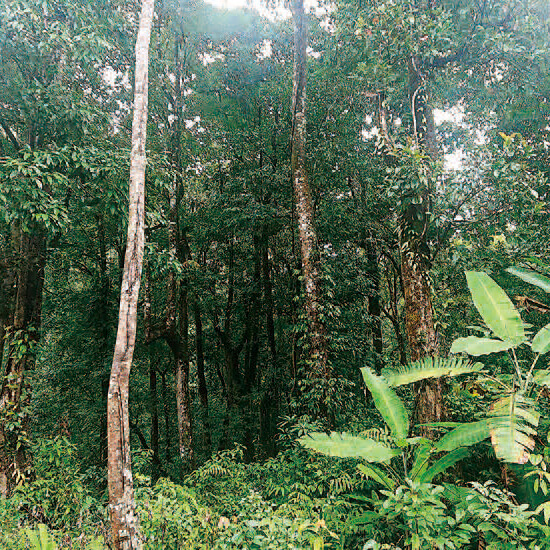
-
More
Forests must be cultivated and managed over long periods of time, spanning multiple generations of people. The objective of research and education in Forest Environmental and Management Sciences is to maintain healthy forest resources over enormously long periods of time. Specifically, education and research cover topics such as conservation of the natural environment and land, elucidation of the functions of forests related to the prevention and mitigation of natural disasters, development of new technologies to measure forest resources, and forest management and policy that balances timber production and environmental conservation.
The Devastation of Forests Due to Increase in Torrential Rain (Left) and Their Restoration and Reforestation (Right) are Important Issues
Climate change on a global scale that emerged in the last century has caused a statistically significant increase in heavy rain in Kyushu and other regions, and landslides triggered by the heavy rain on stable forest slopes have become a common sight (left); therefore, maintaining the sustainability of forests and the forestry industry by mitigating forest resource damage and reforesting (such as hillside slope stabilizations on the right) are important issues not only in Japan but around the world.
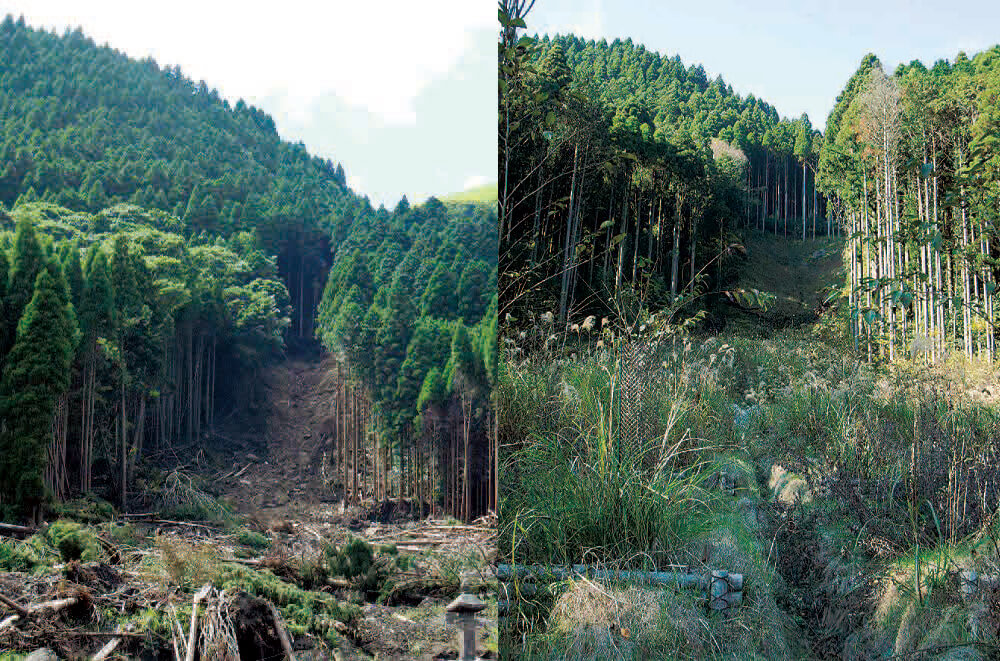
Recent Disaster Caused by Debris Flows and Woody Debris Damage from Forest Slopes
Boulders and woody debris gather at the front of debris flows and sometimes destroy homes. Ideally, forests should be managed properly so there is no woody debris.
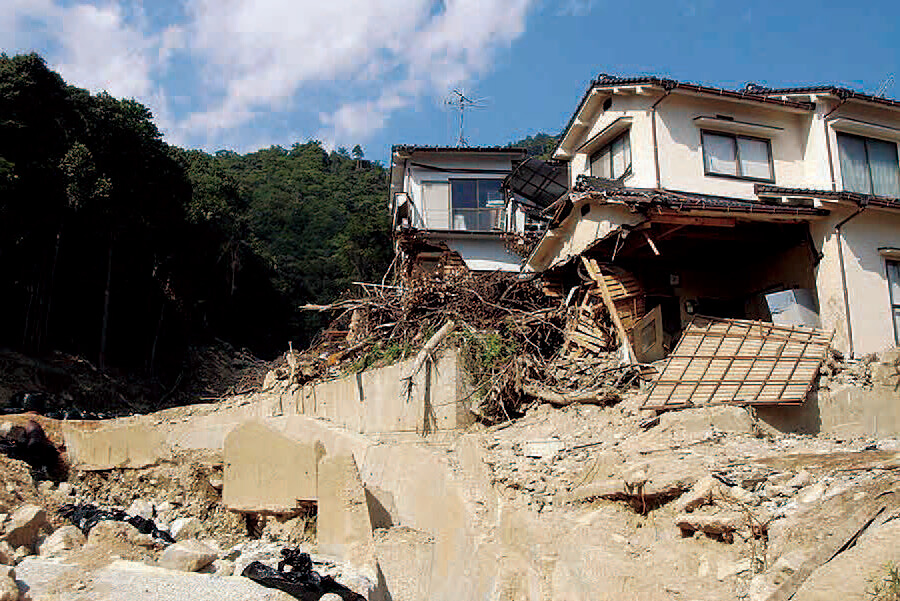
Log production enterprise operating cross prefectures
This photo shows an interview with a log production enterprise headquartered in the north part of Miyazaki Prefecture and operating in the southern part of Oita Prefecture. Thanks to the maturity of vast Japanese cedar (sugi) and cypress (hinoki) plantation resources as well as the implementation of forestry policy, Kyushu has become one of the main log production areas in Japan. With enterprises and timbers are moving back and forth across prefectural borders, we collect data on forestry business and timber distribution on the ground to explore policy issues
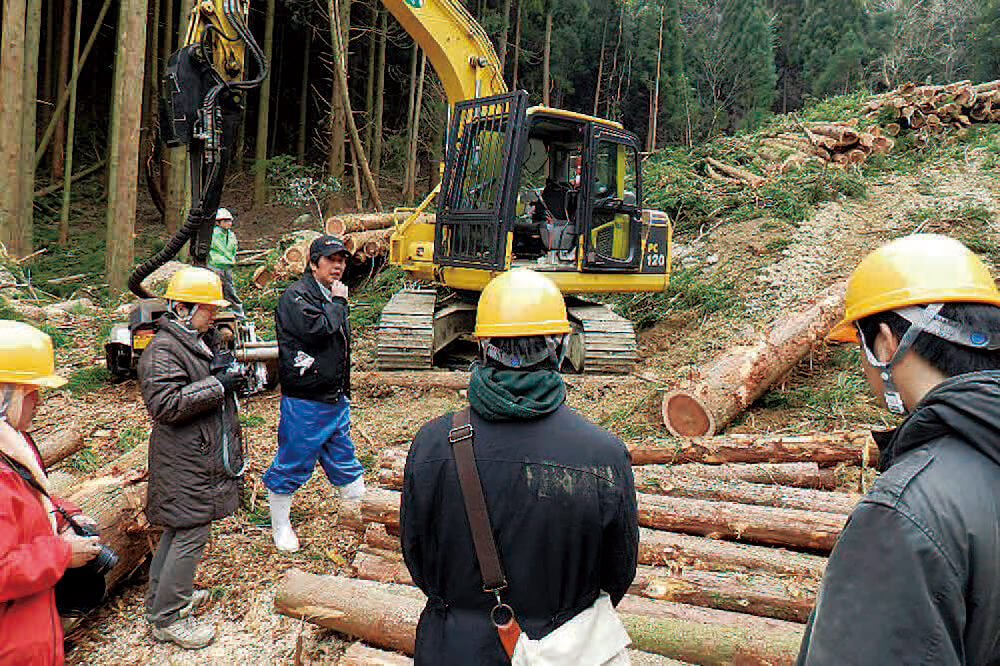
Tropical Rainforests in Southeast Asia
Tropical rainforests have many roles. For example, they play an important role in mitigating global warming, and they support the livelihoods of the people who live there by supplying firewood, charcoal, and timber. Utilizing a variety of methods such as forest surveys, interviews, and analysis of satellite images, we search for forest management methods that are in line with various forests’ roles.
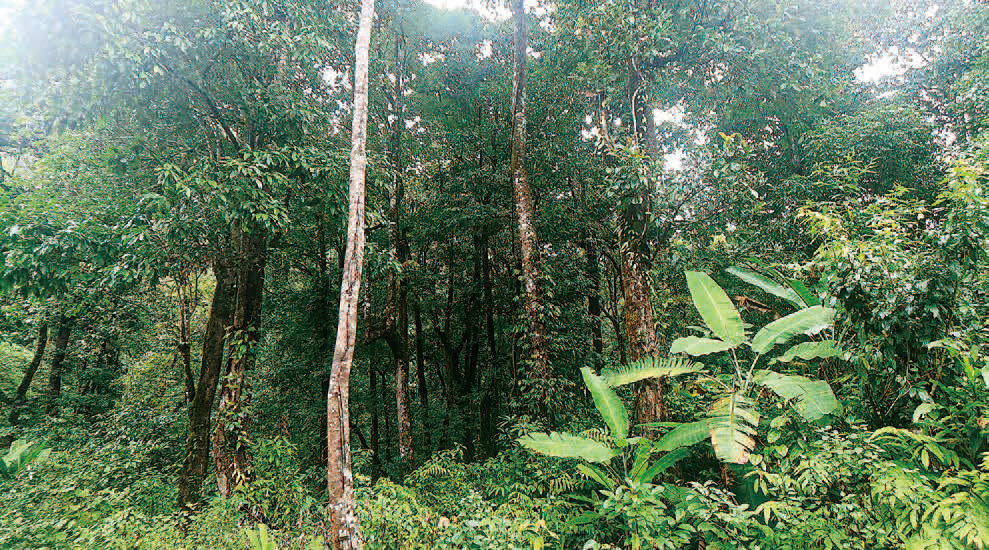
Message from the Director
Forests have many functions such as maintaining biodiversity, preserving water resources and land, supplying food and wood, creating comfortable living environments, and providing recreational spaces. Recently, it has been found that about 20% of the increase of carbon dioxide in the atmosphere has been caused from deforestation, especially in tropical rainforests, and forests’ function to mitigate global warming has drawn attention. Since forests are important renewable resources, we need to conserve healthy and rich forests and establish a cycle of proper cutting, use, regenerationel, and growth. Sometimes forests need to be managed for over 1,000 years to improve various forest functions and facilitate a balance between environments and socioeconomics.
Education and research in Forest Environmental and Management Sciences focus on the conservation of the natural environment and land, elucidation of the functions of forests to prevent and mitigate natural disasters, development of new technologies to measure forest resources, sustainable forest management and planning, and policies on forests. This specialization comprises three field research laboratories—Erosion Control, Forest Management, and Forest Policy—which provide education in collaboration with each other. A unique feature of this specialization is that it takes a holistic approach, using the perspectives of both natural sciences and social sciences to achieve sustainable forest maintenance and management.Prof. Nobuya Mizoue, Program Director, Forest Environmental and Management Sciences

Laboratory List
Forest Biosciences
Exploring Unknown Functions of Forest Ecosystems
Extensive research and education are conducted on subjects ranging from the molecular and material to the ecological level, all aimed at actively developing the various functions of forest creatures and their complex environment for new applications, preserving and restoring the global environment, and making optimal use of forest resources in harmony with nature.
LABORATORY
Silviculture, Wood Science, Forest Chemistry and Biochemistry, Systematic Forest and Forest Products Science
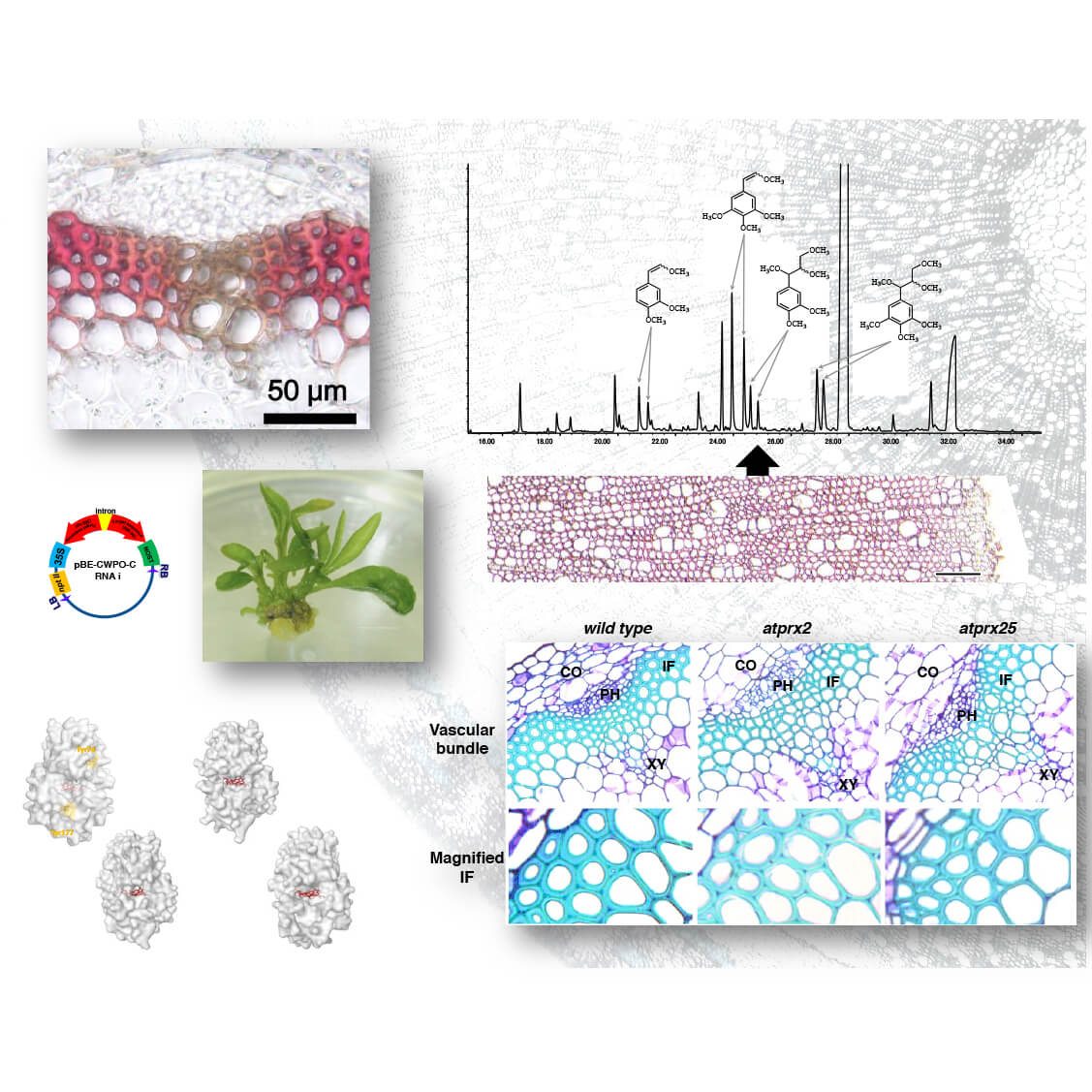
-
More
The Structure of Wood
Xylem forms inside the trunk due to the activities of the vascular cambium. The xylem that has accumulated over years called wood and constitutes the trunk. Wood is composed mainly of carbon, hydrogen, and oxygen, so trees contribute to the continuous fixation of carbon.
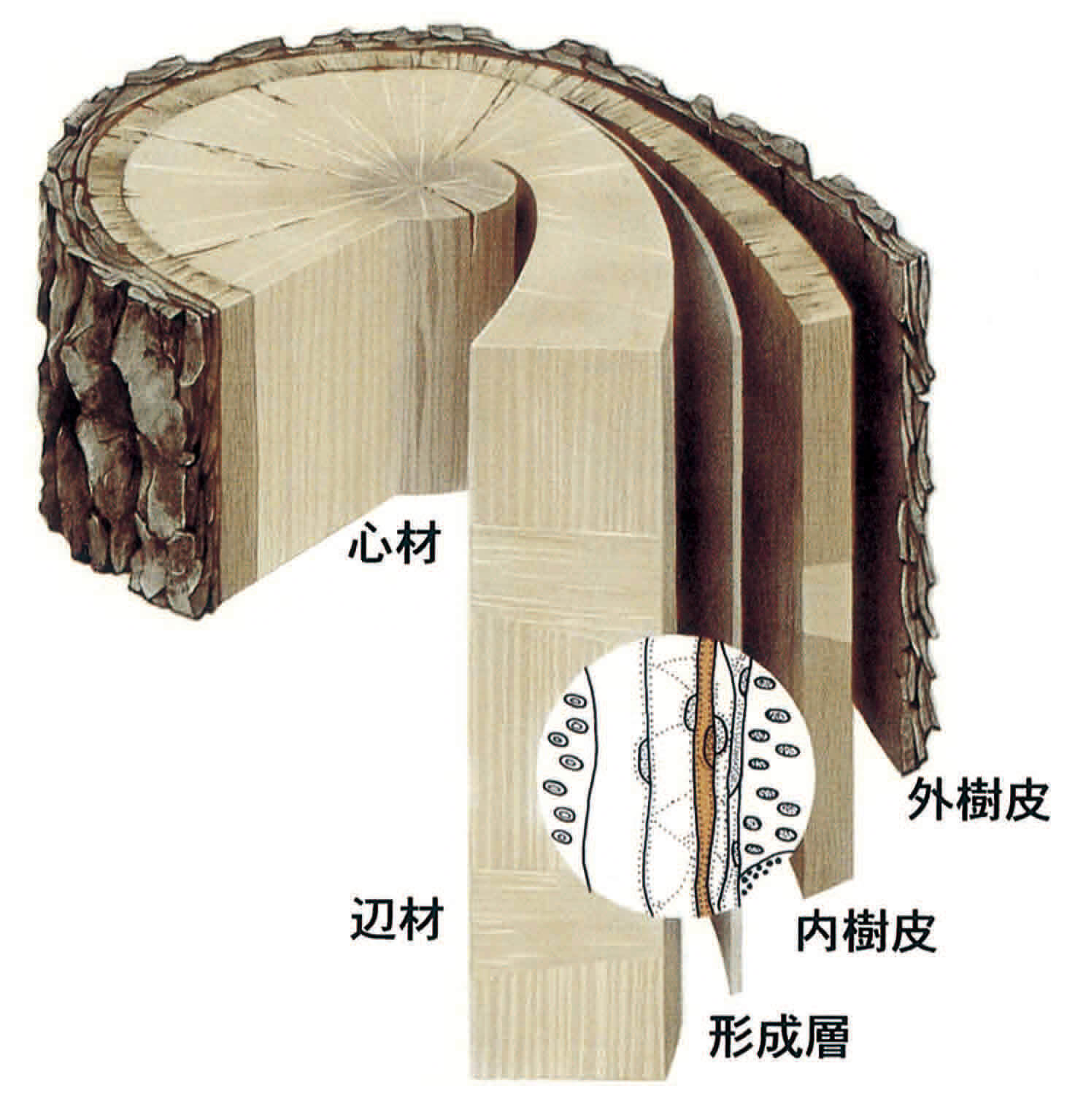
(The illustration above is from Sekai no mokuzai (“Wood of the World”) published by Shogakukan.)
The Mystery of Leaves
In plant cells, a variety of substances move between cytoplasm and various cellular organelles, such as chloroplasts, mitochondria, and peroxisomes. Changes in the amount and rate of moving substances have a significant impact on the photosynthetic efficiency and tree growth. Rapid advancements have been made in technology to measure and control the movement of such substances without damaging the leaves.

Interdisciplinary Science of the Formation of Tree Cell Walls
By leveraging genetic engineering, biosynthetic enzyme chemistry, and tissue science to shed light on the mechanisms of the formation of tree cell walls, which make up 90% of the biomass on Earth, and developing wood that is easy to use for bioethanol, raw materials for chemical products, paper, pulp, and other materials, we are striving to build a sustainable and renewable society with little carbon dioxide emissions.
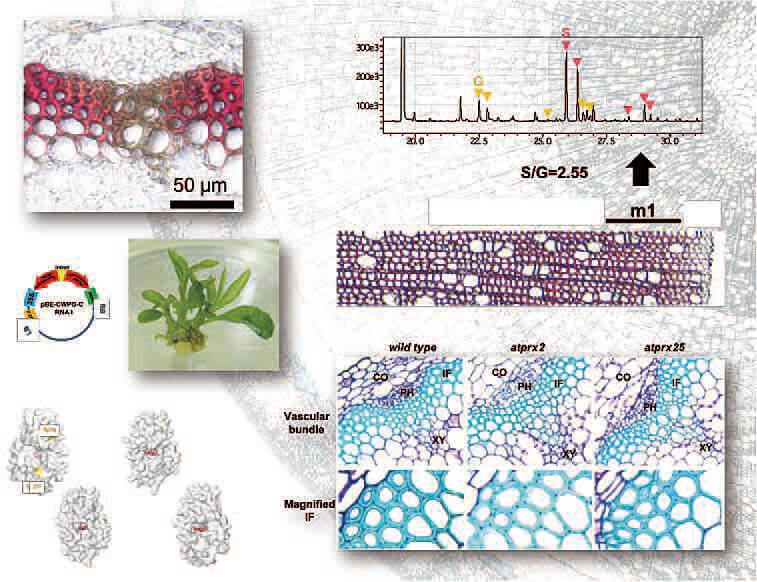
Forests and DNA Research
This is a photo of a tropical rainforest in Southeast Asia (dipterocarp forest). It is rapidly disappearing, which is a serious problem for the environment. DNA research to protect the genetic resources of tropical regions and restore and renew tropical rainforests is being conducted on a global scale. (The photo below is of DNA nucleic acid sequence analysis.)
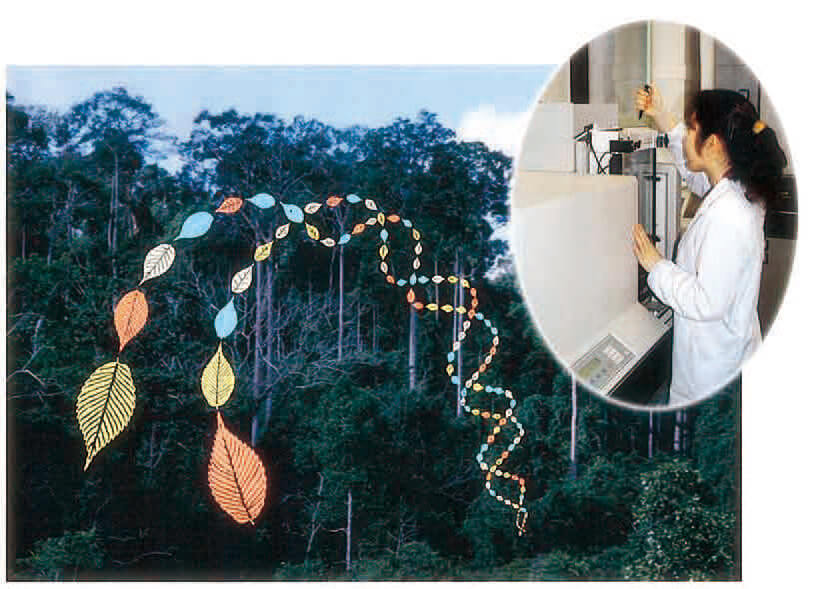
Searching Fast-Growing Broad-Leafed Japanese Trees Ideal for Interior Design
Fast-growing trees have a high carbon fixation capacity and contribute to the mitigation of global warming. And due to the short time from planting to harvest, they can be bred to produce high-quality timber for the next generation. The photo shows a prototype chair made with a previously unused Japanese fast-growing broad-leafed tree species that was chosen for its suitability for interior design. It has received high acclaim from the interior design industry.

Functionality of Mushrooms
The above are X-ray CT scan images of mice (abdomen) fed high-fat feed for 40 days. The black areas are body fat, the white areas are bone, and the gray are muscle and organs. The group on the left was fed high-fat food and the group on the right was fed high-fat food containing 5% mushrooms, showing that feeding them mushrooms reduces subcutaneous and visceral fat.

Message from the Director
Unlocking the Mysteries of Forest Ecosystems with DNA
Forests are the most diverse ecosystems in the world, and they hold a treasure trove of genetic information. Understanding and preserving the biodiversity that developed throughout the earth’s long history and that genetic information is essential for our lives. In this specialization, we elucidate the complex living phenomena of the forest through DNA, and conduct research to cultivate forests with better properties.Utilizing the Latent Benefits of Forest Organisms
The diverse range of trees, mushrooms, and other organisms that make up forests synthesize, accumulate, and release a variety of chemicals. We search for beneficial chemicals with antibacterial, anti-cancer, relaxation, and other bioactivities, and shed light on their biosynthesis mechanisms. We also conduct research to promote healthy and comfortable environments that make use of forest resources.Wood Science
Wood is strong yet resilient, and has many other features as well. It is environmentally friendly and an essential resource for humanity to live in comfort and safety. We evaluate the cultivation and characteristics of trees, and conduct research on creating nextgen wood resources.Elucidating the Functions of Trees on the Molecular Level
Trees convert light energy into chemical energy. Chloroplasts fix carbon dioxide and convert it into high molecular compounds such as cellulose and lignin, which are stored in the trunk. We research the physiological mechanisms on the genetic and molecular level to improve trees’ carbon storage efficiency and environmental adaptability.Striving to Create a Recycling Society with Sophisticated Use of Woody Biomass
Sophisticated use of trees (woody biomass) as a renewable resource is a key solution to global warming and the depletion of fossil fuels. We are also working on developing technology to convert unused wood and woody biomass waste to fuel, and on research to improve the usability of woody biomass through genetic engineering.Prof. Atsushi Kume, Program Director, Forest Biosciences

Biomaterial Sciences
Striving for Sophisticated People- and Environmental-Friendly Use of Forest Resources
This specialised area covers research on the advanced use of biomaterials, especially wood products. The research topics include advanced physical and chemical utilization of forest bioresources and highly organized engineering of forest-related environmental issues. All of this research is done with the goal of realizing the coexistence of an affluent society with the preservation of the global environment, thus requiring the wide-ranging education we offer.
LABORATORY
Wood Materials Technology, Bioresources Chemistry, Biomacromolecular Materials, Biomaterial Design
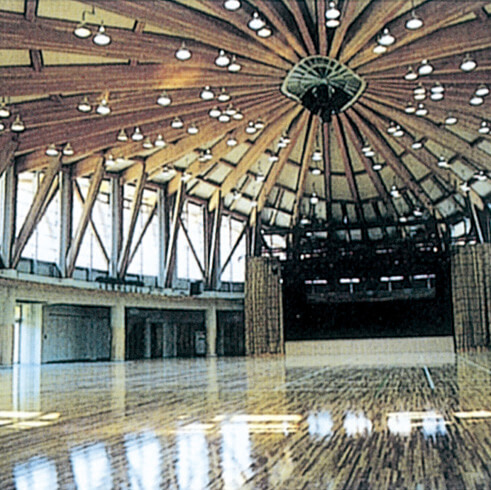
-
More
Exterior and Interior of Wooden Dome Made with Large Sectional Laminated Timber
Because wooden houses and structures store carbon dioxide and are made of wood—a material that has little impact on the environment—they are referred to as “secondary forests.” Therefore, making more of them and using them for a long time is just as valuable as afforestation.
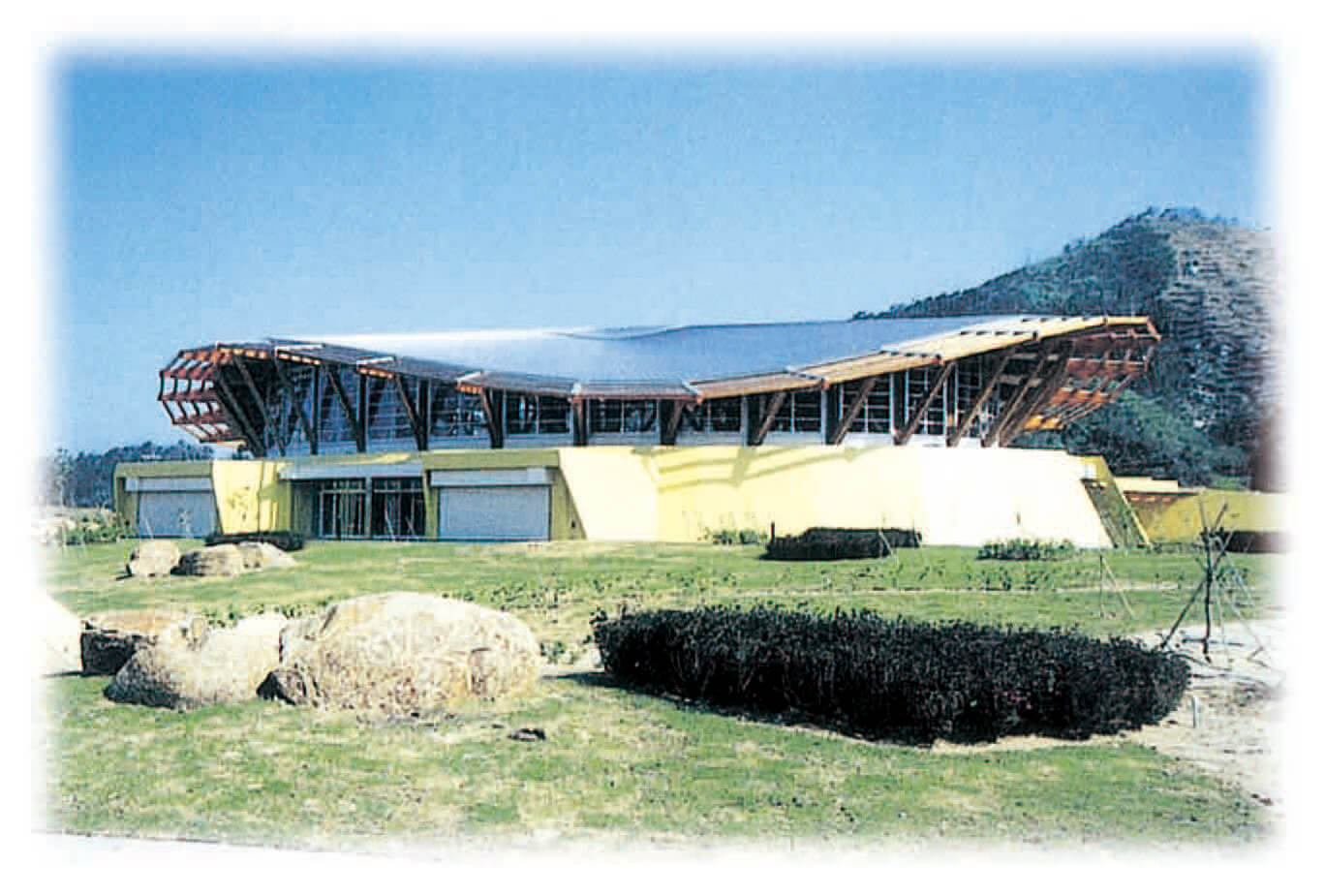

Using Durable, Rot-resistant Wood
When using wood outdoors, it is important to carry out rot and insect prevention treatment to increase durability and enable the wood to remain beautiful for a long time. It also helps protect forest resources. The photos are of a durable, rot-resistant fence and outdoor play equipment, in which the wood has been injected with chemicals.
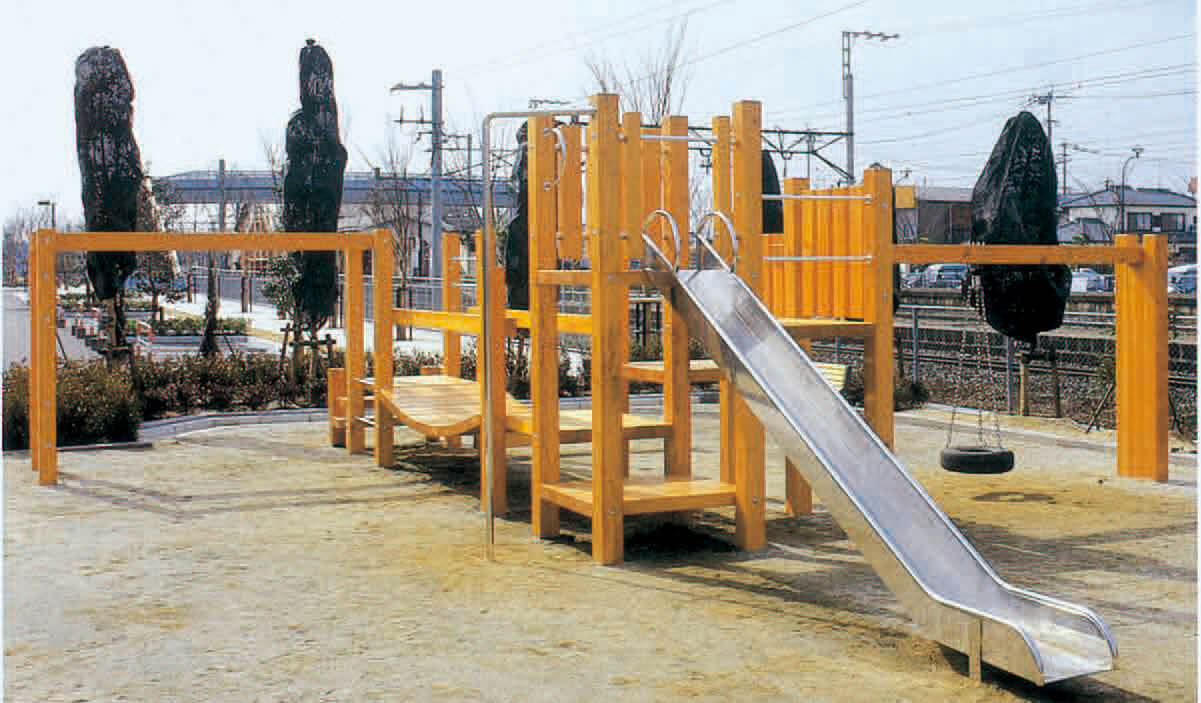
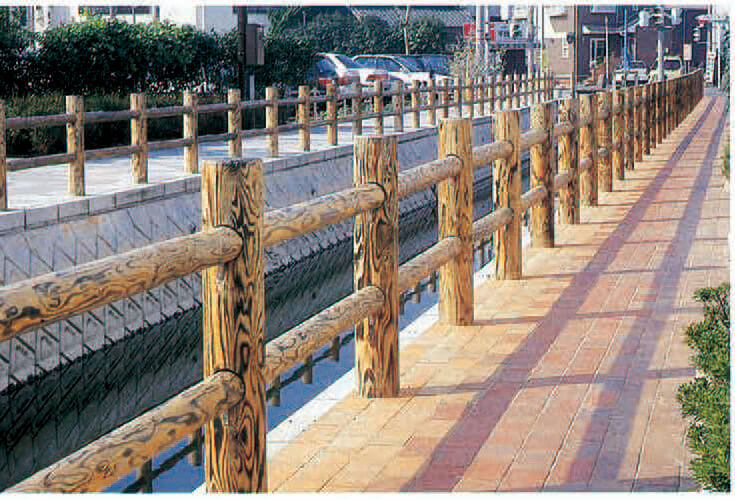
Elemental Analysis of the Surface of High-Performance Paper with X-Ray Photoelectron Spectroscopy
Of all biomaterials, the one we are most familiar with is paper. It is composed mainly of cellulose, the most well-known forest resource. We conduct research on systems that provide new functions such as durability and water repellency while keeping paper’s outstanding environmental compatibility (biodegradability), and on elucidating the mechanisms that express those functions (see photo). We are also working on developing new functional materials that can purify environmental pollutants by combining cellulose fiber and inorganic catalysts.
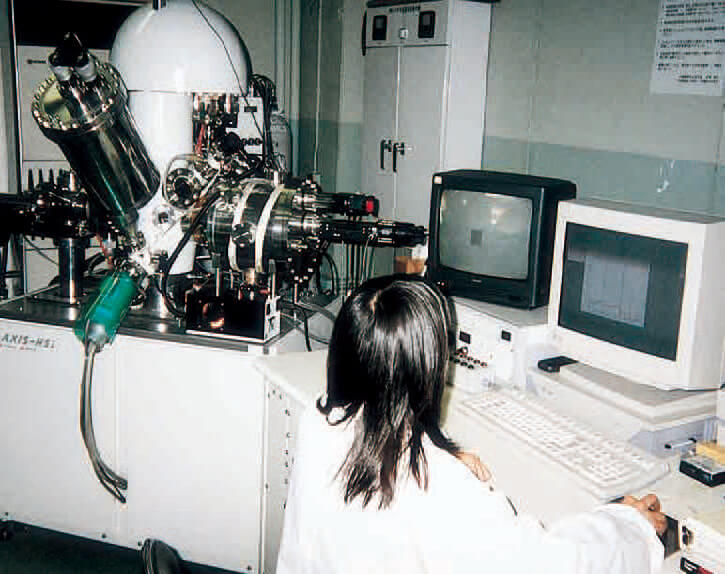
Honeycomb Film Made of Cellulose
Substances with a variety of patterns and functions (e.g., film and 3D fiber structures) are being designed and developed from cellulose, the main component of biomass. Identifying the correlation between these patterns and functions will open up further possibilities for material design.
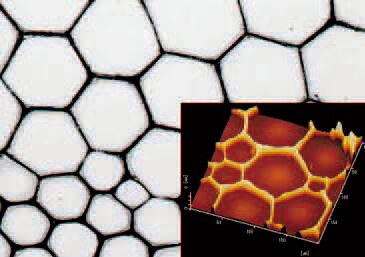
Shedding Light on the Biofunctions of Mushrooms
Basidiomycota as a mushroom, is the most well-known and the most advanced eukaryote microorganisms possessing astonishing material conversion functions. In order to fully understand and utilize this ability, we are conducting uncompromising, exhaustive analyses, such as analyzing gene-expression networks, all proteins, and the mechanisms of action of key enzymes. Our hope is to develop new biomass conversion technology that applies this function, and use the technology to strengthen and design the function even further.
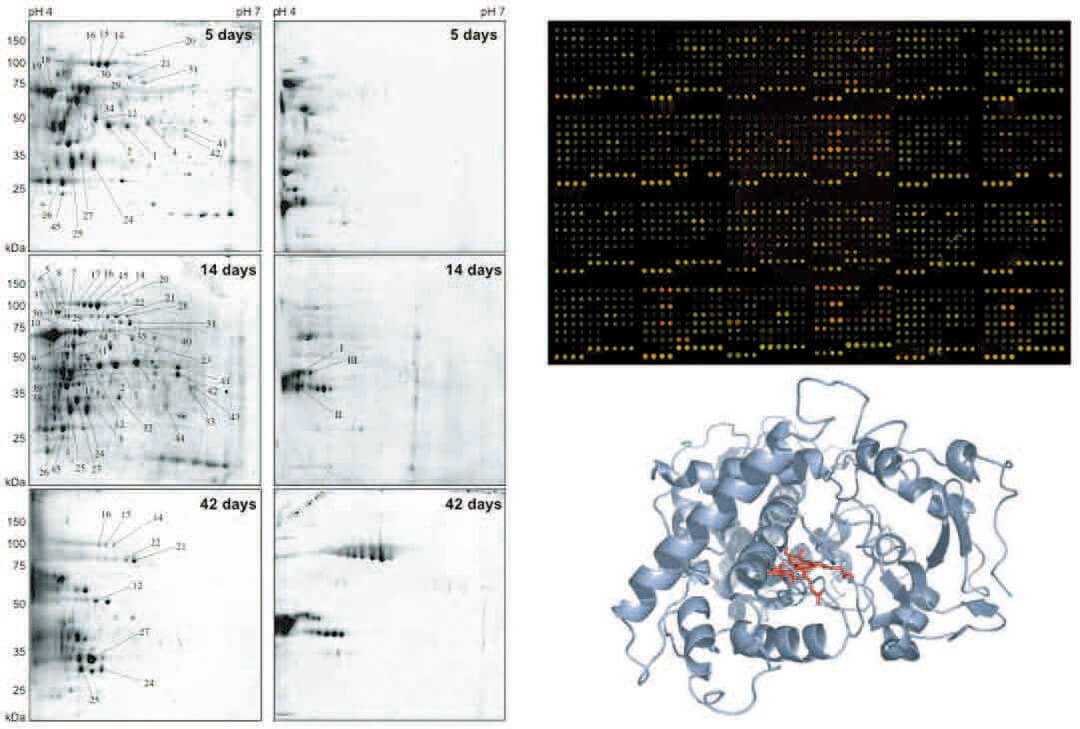
Message from the Director
For our safe and comfortable lives, the entire living system needs to be based upon “sustainable and environmentally friendly manufacturing” and “energy production”. Now, the time has come for the goal. Namely, we must stop thinking the last century’s priority for cost-oriented and unsustainable production efficiency and besides our consumption behavior. To date, we have totally neglected coexistence with the ecosystem. Instead, we must now place ourselves within the earth’s inherent renewable cycle of materials and energy.
Biomaterial Sciences deals with searching for undiscovered functions of biomaterials with a focus on wood, in order to establish a balance advancement of society with the natural environment. Trees are organisms that relay the carbon and water cycle of the geosphere, and renewable biomass resources that can live hundreds or even thousands of years. In this specialization, we utilize physical and chemical engineering techniques and nano-biotechnology to conduct pioneering research on the functions of cutting-edge materials, with a focus on the hierarchical structure of trees from the nano to the macro level. Specifically, we practice broad “material science that learns from nature,” carrying out projects such as using trees with long lifespans for long-term wood use, creating electronic devices and medical materials through hybridization and controlling nano-structures of natural polysaccharides, developing innovative nano-processing technology solely using water, and researching how to utilize the material conversion function of mushrooms—which decompose trees—into discovering drug effects and fine chemical synthesis.
Students aiming at agronomy love nature. Bringing your mindset as a motivation into biomaterial sciences, we have been performing our own education, research, and training based on the belief that agronomy can bring about pioneering innovation in green materials and that it is possible to build a truly abundant society.Prof. Tetsuo Kondo, Program Director, Biomaterial Sciences

Let's Watch!
We have a video that introduces each field and lab to the public.
They have English subtitles, so be sure to check them out!